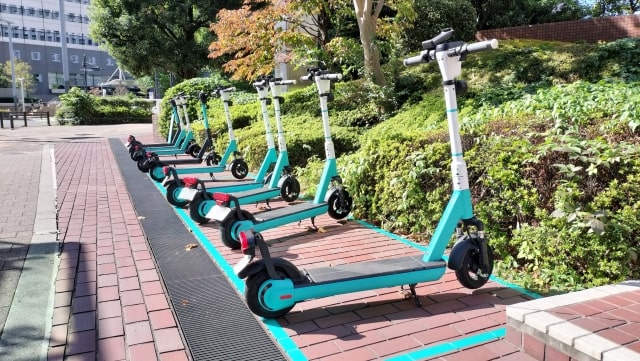In recent years, LUUP’s electric scooter sharing service has rapidly spread across urban areas. While it is praised as an environmentally friendly transportation option, it has also sparked significant concerns regarding safety and public nuisance. This article delves into the risks and issues posed by LUUP’s electric scooters and explores potential solutions for safer use.
What is LUUP?
LUUP is a Japanese company offering electric scooter and electric bike sharing services. The service is popular due to its ease of use via an app, making it a convenient transportation option in urban areas. It is especially favored for avoiding traffic congestion and reducing environmental impact. However, with the rapid expansion of LUUP’s services, numerous safety concerns and public nuisances have arisen.
Safety Issues with Electric Scooters
Electric scooters fall somewhere between vehicles and pedestrians, and this unique position brings specific safety risks. One primary issue is the difficulty in controlling speed. Many electric scooters can reach speeds of over 20 kilometers per hour, which can result in severe accidents if users, particularly beginners, are not familiar with handling them. Additionally, riders who lack proper knowledge of traffic rules may ride on sidewalks, putting pedestrians at risk.
For instance, in 2023, an accident occurred in Shibuya, Tokyo, where an electric scooter collided with a pedestrian. Although the scooter in question was not from LUUP, it highlights the risks posed by similar services. The number of incidents involving LUUP scooters is expected to rise, indicating a need for stricter regulations.

LUUP’s Expansion and Public Criticism
In 2024, LUUP rapidly expanded by establishing more ports in many cities, which led to a surge of public criticism. On social media platforms like X (formerly Twitter), many complaints were voiced about LUUP ports occupying public spaces. Additionally, users frequently fail to park scooters properly, blocking sidewalks and bike lanes, thus becoming a nuisance for pedestrians and cyclists alike.
Comments like “LUUP electric scooters are always in the way, blocking paths,” are common on social media, indicating that users’ failure to follow rules is disrupting public order. This is especially problematic in busy areas or tourist destinations where visitors, unfamiliar with the rules, contribute to the chaos.
LUUP’s Impact on Public Safety
LUUP’s electric scooters are often used on narrow streets and sidewalks in urban areas, posing a significant threat to pedestrians. There is a heightened risk of collisions when scooters are ridden on sidewalks or left improperly parked after use. For elderly individuals and children, the sudden approach of fast-moving electric scooters can cause considerable stress and danger.
News reports have highlighted incidents where LUUP scooters were left in public spaces, causing pedestrians to trip and injure themselves. These issues not only raise concerns about users’ behavior but also call into question the management system of service providers like LUUP.
The Inconvenience and Nuisance of LUUP
In addition to safety concerns, many users have pointed out issues with LUUP’s service. For instance, even when the app shows the location of a scooter, it’s often not there when users arrive. Additionally, many scooters are poorly maintained, with dead batteries or mechanical failures being frequent complaints.
These inconveniences lead to users abandoning scooters carelessly or ignoring rules when switching to other modes of transport, which further amplifies the criticism of LUUP.
Government Regulations and Enforcement
In Japan, regulations regarding electric scooters have been strengthened in recent years. With the 2022 amendment to the Road Traffic Act, electric scooters can be ridden on roads under specific conditions, but riding on sidewalks is prohibited, and helmet-wearing is recommended. However, the strictness of these regulations and their enforcement remains unclear.
While services like LUUP are rapidly expanding, there is a growing concern that appropriate oversight and penalties for violations have not kept pace. If more users continue to flout the rules while using electric scooters, further accidents and problems may arise.
Possible Solutions and Alternatives
For LUUP to be used safely, the service provider must take additional steps. Strengthening user education is crucial, such as incorporating safety driving courses within the app or requiring users to take a short test before their first ride. This could raise awareness of the minimum safety requirements.
Furthermore, clearly defined parking areas should be set up, and users should be required to return scooters to designated spots after use. This would help resolve the issue of public space congestion.
Additionally, promoting alternative modes of transport, such as bike-sharing or public transport, could reduce the reliance on electric scooters, thereby improving overall urban safety.
Conclusion: Caution is Needed When Using LUUP
While LUUP’s electric scooters are praised as a convenient and eco-friendly mode of transportation, they come with numerous safety risks and public nuisances. Both service providers and users need to make an effort to ensure that scooters are used responsibly and do not disrupt public order. When using LUUP scooters, always prioritize safety, drive responsibly, and be considerate of pedestrians and other users.








Comments